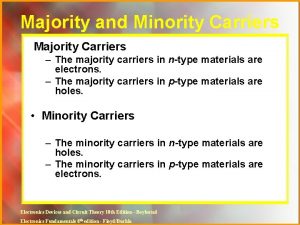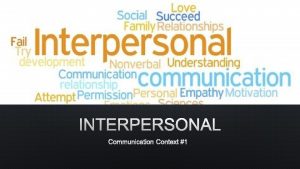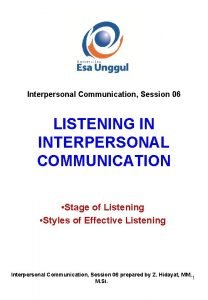INTERPERSONAL COMMUNICATION IN CLOSE RELATIONSHIPS 10 Floyd Interpersonal


![[ Communicating in Friendships ] One of the defining features of friendships is that [ Communicating in Friendships ] One of the defining features of friendships is that](https://slidetodoc.com/presentation_image_h2/c282e897d59cdb004847c22ef0b11aab/image-3.jpg)





![[ Communicating in Romantic Relationships ] Around the world, romantic relationships differ in how [ Communicating in Romantic Relationships ] Around the world, romantic relationships differ in how](https://slidetodoc.com/presentation_image_h2/c282e897d59cdb004847c22ef0b11aab/image-9.jpg)

![[ Communicating in Romantic Relationships (Conflict) ] Romantic relationships vary in how they handle [ Communicating in Romantic Relationships (Conflict) ] Romantic relationships vary in how they handle](https://slidetodoc.com/presentation_image_h2/c282e897d59cdb004847c22ef0b11aab/image-11.jpg)







![[ Communicating in Families (Stories) Families tell stories ] • Family stories give families [ Communicating in Families (Stories) Families tell stories ] • Family stories give families](https://slidetodoc.com/presentation_image_h2/c282e897d59cdb004847c22ef0b11aab/image-19.jpg)
![[ Communicating in Families (Secrets) Families share secrets ] • Some families have secrets [ Communicating in Families (Secrets) Families share secrets ] • Some families have secrets](https://slidetodoc.com/presentation_image_h2/c282e897d59cdb004847c22ef0b11aab/image-20.jpg)

![[ Communicating in the Workplace (Superiors) ] Social relationships can form between superiors and [ Communicating in the Workplace (Superiors) ] Social relationships can form between superiors and](https://slidetodoc.com/presentation_image_h2/c282e897d59cdb004847c22ef0b11aab/image-22.jpg)
![[ Communicating in the Workplace (Clients) Social relationships can form with clients ] • [ Communicating in the Workplace (Clients) Social relationships can form with clients ] •](https://slidetodoc.com/presentation_image_h2/c282e897d59cdb004847c22ef0b11aab/image-23.jpg)


- Slides: 25

INTERPERSONAL COMMUNICATION IN CLOSE RELATIONSHIPS 10 Floyd, Interpersonal Communication, 3 e ©Mc. Graw-Hill Education. All rights reserved. Authorized only for instructor use in the classroom. No reproduction or further distribution permitted without the prior written consent of Mc. Graw-Hill Education.

[ Our Agenda • Communicating in Friendships • Communicating in Romantic Relationships • Communicating in Families • Communicating in the Workplace ©Mc. Graw-Hill Education. ]
![Communicating in Friendships One of the defining features of friendships is that [ Communicating in Friendships ] One of the defining features of friendships is that](https://slidetodoc.com/presentation_image_h2/c282e897d59cdb004847c22ef0b11aab/image-3.jpg)
[ Communicating in Friendships ] One of the defining features of friendships is that they are voluntary • We choose our friends and they choose us • We do not have to be friends with anyone we don’t want to be friends with ©Mc. Graw-Hill Education.

[ Communicating in Friendships (Peers) Friendships are usually relationships between peers • A peer is someone similar in power or status to oneself ] • Friendships with non-peers are possible but are often more challenging, because of the power difference ©Mc. Graw-Hill Education.

[ Communicating in Friendships (Rules) Friendships are governed by rules • A friendship is like a social contract to which both parties agree • Common rules in friendships: • Stand up for your friends and support them • Be enjoyable to be around • Provide help even without being asked ] • Be the kind of person with whom friends can share thoughts and secrets ©Mc. Graw-Hill Education.

[ Communicating in Friendships (Sex) Friendships often differ by sex • In same-sex friendships, men often value shared activity more than shared conversation, whereas women often value shared conversation more ] • In opposite-sex friendships, flirtatious—even sexual —behavior is relatively common even if those friendships never turn romantic ©Mc. Graw-Hill Education.

[ Communicating in Friendships (Life Span) Friendships have a life span • Role-limited interaction • Friendly relations • Moves toward friendship • Nascent friendship • Stabilized friendship • Waning friendship ©Mc. Graw-Hill Education. ] © Mixa/Getty Images, RF

[ Communicating in Friendships (Endings) Friendships can end for at least two reasons • The friends grow to dislike each other • The friends’ life circumstances can change ©Mc. Graw-Hill Education. ]
![Communicating in Romantic Relationships Around the world romantic relationships differ in how [ Communicating in Romantic Relationships ] Around the world, romantic relationships differ in how](https://slidetodoc.com/presentation_image_h2/c282e897d59cdb004847c22ef0b11aab/image-9.jpg)
[ Communicating in Romantic Relationships ] Around the world, romantic relationships differ in how much they emphasize • Exclusivity • Voluntariness • Love • Sexuality • Permanence ©Mc. Graw-Hill Education.

[ Communicating in Romantic Relationships (Marital Types) Fitzpatrick differentiates between marital types • Traditional • Separate • Independent • Mixed ©Mc. Graw-Hill Education. ] © Max Riesgo/Getty Images, RF
![Communicating in Romantic Relationships Conflict Romantic relationships vary in how they handle [ Communicating in Romantic Relationships (Conflict) ] Romantic relationships vary in how they handle](https://slidetodoc.com/presentation_image_h2/c282e897d59cdb004847c22ef0b11aab/image-11.jpg)
[ Communicating in Romantic Relationships (Conflict) ] Romantic relationships vary in how they handle conflict • Validating couples discuss disagreements openly and cooperatively • Volatile couples discuss disagreements openly but competitively • Conflict-avoiding couples discuss disagreements covertly rather than openly • Hostile couples have frequent, intense conflict ©Mc. Graw-Hill Education.

[ Communicating in Romantic Relationships (Privacy) Romantic relationships vary in how they handle privacy • Petronio proposed communication privacy management (CPM) theory to explain the tension between privacy and disclosure • Partners in a couple jointly own the information about their relationship • We form and manage privacy boundaries ©Mc. Graw-Hill Education. ]

[ Communicating in Romantic Relationships (Emotions) Romantic relationships vary in how they handle emotional communication • Happy partners share more positive emotion and less negative emotion than do unhappy partners • Unhappy partners are more likely than happy partners to reciprocate expressions of negative emotion ©Mc. Graw-Hill Education. ]

[ Communicating in Romantic Relationships (Instrumental) Romantic relationships vary in how they handle instrumental communication • Day-to-day tasks require completion • The way in which partners divide everyday tasks often reflects the balance of power in their relationship • Same-sex relationships often divide tasks more equitably than opposite-sex relationships ©Mc. Graw-Hill Education. ]

[ Communicating in Families What makes a family? • Genetic ties • Legal obligations • Role behaviors ©Mc. Graw-Hill Education. ] © Hill Street Studios/Blend Images//Getty Images, RF

[ Communicating in Families (Types) Families come in various types • Family of origin ] • Family of procreation • Nuclear family • Blended family • Single-parent family • Extended family ©Mc. Graw-Hill Education. © Genaro Molina/Los Angeles Times/Contour/Getty Images

[ Communicating in Families (Roles) Families enact roles • Family roles are the functions people serve in the family system • Four roles commonly emerge during conflict • Blamer • Placater • Computer • Distracter ©Mc. Graw-Hill Education. ]

[ Communicating in Families (Rituals) Families enact rituals • Family rituals are repetitive activities that have special meaning for a family • Some family rituals are “imported” from families into blended families ©Mc. Graw-Hill Education. ]
![Communicating in Families Stories Families tell stories Family stories give families [ Communicating in Families (Stories) Families tell stories ] • Family stories give families](https://slidetodoc.com/presentation_image_h2/c282e897d59cdb004847c22ef0b11aab/image-19.jpg)
[ Communicating in Families (Stories) Families tell stories ] • Family stories give families a sense of their history, their expectations, and their connections • Family stories are told and retold • Family stories convey an underlying message about the family ©Mc. Graw-Hill Education.
![Communicating in Families Secrets Families share secrets Some families have secrets [ Communicating in Families (Secrets) Families share secrets ] • Some families have secrets](https://slidetodoc.com/presentation_image_h2/c282e897d59cdb004847c22ef0b11aab/image-20.jpg)
[ Communicating in Families (Secrets) Families share secrets ] • Some families have secrets they intentionally keep hidden from others • Secrets can also be kept within families ©Mc. Graw-Hill Education. © Stockbyte/Thinkstock, RF

[ Communicating in the Workplace Social relationships can form between co-workers, who are usually our peers ] • Friendships with co-workers have both a social dimension and a task dimension, which can conflict with each other • Romantic relationships between co-workers can be beneficial, but can also involve stress and conflicts of interest ©Mc. Graw-Hill Education.
![Communicating in the Workplace Superiors Social relationships can form between superiors and [ Communicating in the Workplace (Superiors) ] Social relationships can form between superiors and](https://slidetodoc.com/presentation_image_h2/c282e897d59cdb004847c22ef0b11aab/image-22.jpg)
[ Communicating in the Workplace (Superiors) ] Social relationships can form between superiors and subordinates • These relationships include a power difference that co -worker relationships generally do not • They often require agreeing to keep professional and personal sides of the relationship separate • They can provide a context for sexual harassment ©Mc. Graw-Hill Education.
![Communicating in the Workplace Clients Social relationships can form with clients [ Communicating in the Workplace (Clients) Social relationships can form with clients ] •](https://slidetodoc.com/presentation_image_h2/c282e897d59cdb004847c22ef0b11aab/image-23.jpg)
[ Communicating in the Workplace (Clients) Social relationships can form with clients ] • Like other workplace relationships, these relationships can experience conflict between social and task dimensions • Some employers and organizations discourage employees from developing personal friendships with customers ©Mc. Graw-Hill Education.

[ Communicating in the Workplace (Tips 1) When communicating online in the workplace, remember these tips: • Learn and follow the organization’s policies for electronic communication ] • Use electronic communication for convenience, not as a shield • Don’t write in an e-mail message what you wouldn’t say in person ©Mc. Graw-Hill Education.

[ Communicating in the Workplace (Tips 2) • Remember that electronic communication leaves a trail ] • Take advantage of the communication trail when it benefits you to do so • Know your audience • Upward communication • Downward communication • Lateral communication ©Mc. Graw-Hill Education.
 What is mass communication
What is mass communication Physical attractiveness
Physical attractiveness What is interpersonal communication
What is interpersonal communication Floyd radigan
Floyd radigan The blanket by floyd dell summary
The blanket by floyd dell summary Floyd warshall parallel
Floyd warshall parallel Transitive closure in discrete mathematics
Transitive closure in discrete mathematics Floyd
Floyd Strongly connected
Strongly connected Floyd digital fundamentals 10th edition pdf
Floyd digital fundamentals 10th edition pdf Floyd warshall algorithm transitive closure
Floyd warshall algorithm transitive closure The blanket by floyd dell questions and answers
The blanket by floyd dell questions and answers Floyd angol együttes
Floyd angol együttes Eds
Eds Thomas l floyd digital fundamentals 10th edition
Thomas l floyd digital fundamentals 10th edition Floyd allport
Floyd allport Amani floyd
Amani floyd Pink floyd scaruffi
Pink floyd scaruffi Belgische powerpoint presentatie pink floyd
Belgische powerpoint presentatie pink floyd Electronic devices floyd 10th edition
Electronic devices floyd 10th edition Digital fundamentals 10th edition
Digital fundamentals 10th edition Algoritmo floyd
Algoritmo floyd Floyd-warshall演算法
Floyd-warshall演算法 Algoritmo de floyd-warshall
Algoritmo de floyd-warshall The blanket by floyd dell symbolism
The blanket by floyd dell symbolism Consumerism songs
Consumerism songs

















































